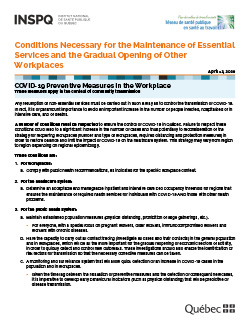COVID-19: Conditions Necessary for the Maintenance of Essential Services and the Gradual Opening of Other Workplaces
COVID-19 Preventive Measures in the Workplace
These measures apply in the context of sustained community transmission.
Any resumption of non-essential services must be carried out in such a way as to control the transmission of COVID-19. In fact, it is of paramount importance to avoid an important increase in the number of people infected, hospitalized or in intensive care, and of deaths.
A number of conditions must be respected to ensure the control of COVID-19 in Québec. Failure to respect these conditions could lead to a significant increase in the number of cases and thus potentially to reconsideration of the strategy for reopening workplaces (number and type of workplaces, required distancing and protection measures) in order to restore balance and limit the impact of COVID-19 on the healthcare system. This strategy may vary from region to region depending on regional epidemiology.
These conditions are:
- For workplaces:
- Comply with public health recommendations, as indicated for the specific workplace context.
- For the healthcare system:
- Determine an acceptable and manageable inpatient and intensive care bed occupancy threshold for regions that ensures the maintenance of required health services for individuals with COVID-19 AND those with other health problems.
- For the public health system:
- Maintain established population measures (physical distancing, prohibition of large gatherings, etc.).
- For everyone, with a special focus on pregnant workers, older workers, immunocompromised workers and workers with chronic diseases.
- Have the capacity to carry out all contact tracing (investigate all cases and their contacts) in the general population and in workplaces, which will be all the more important for the gradual reopening of economic sectors of activity, in order to quickly detect and control new outbreaks. These investigations should also enable the identification of risk factors for transmission so that the necessary corrective measures can be taken.
- A monitoring and surveillance system that will allow quick detection of an increase in COVID-19 cases in the population and in workplaces.
- Given the time lag between the relaxation of preventive measures and the detection of consequent new cases, it is imperative to develop early behavioural indicators (such as physical distancing) that will be predictive of disease transmission.
- A significant increase in laboratory testing capacity to allow the timely evaluation of any person meeting the screening criteria and all contacts who become symptomatic (if they meet the screening criteria).
- In the context of a gradual reopening of workplaces, it is of paramount importance that the screening of workers remains a high priority (cases and contacts that become symptomatic) and that laboratory capacity adjusted accordingly.
- Maintain established population measures (physical distancing, prohibition of large gatherings, etc.).
- To have protective equipment available in sufficient quantities:
- For healthcare personnel.
- For workers in other sectors, when recommended.
- For people with COVID-19, in order to protect others.
- To develop and use knowledge, which is of significant importance to decision making in order to:
- Determine how many people have already been infected in a community.
- Assess whether people develop long-term immunity.
- Have knowledge of the best methods of protection.
- Examine any other emerging research priorities related to COVID-19.
AUTHOR
SAT-COVID-19 Working Group
Institut national de santé publique du Québec
TRANSLATION
Nina Alexakis Gilbert, revised by Nektaria Nicolakakis
The preceding recommendations are based on the latest available information at the time of writing. Given that the situation and knowledge about the SARS-CoV-2 virus (COVID-19) are evolving rapidly, the recommendations in this document are subject to change.


